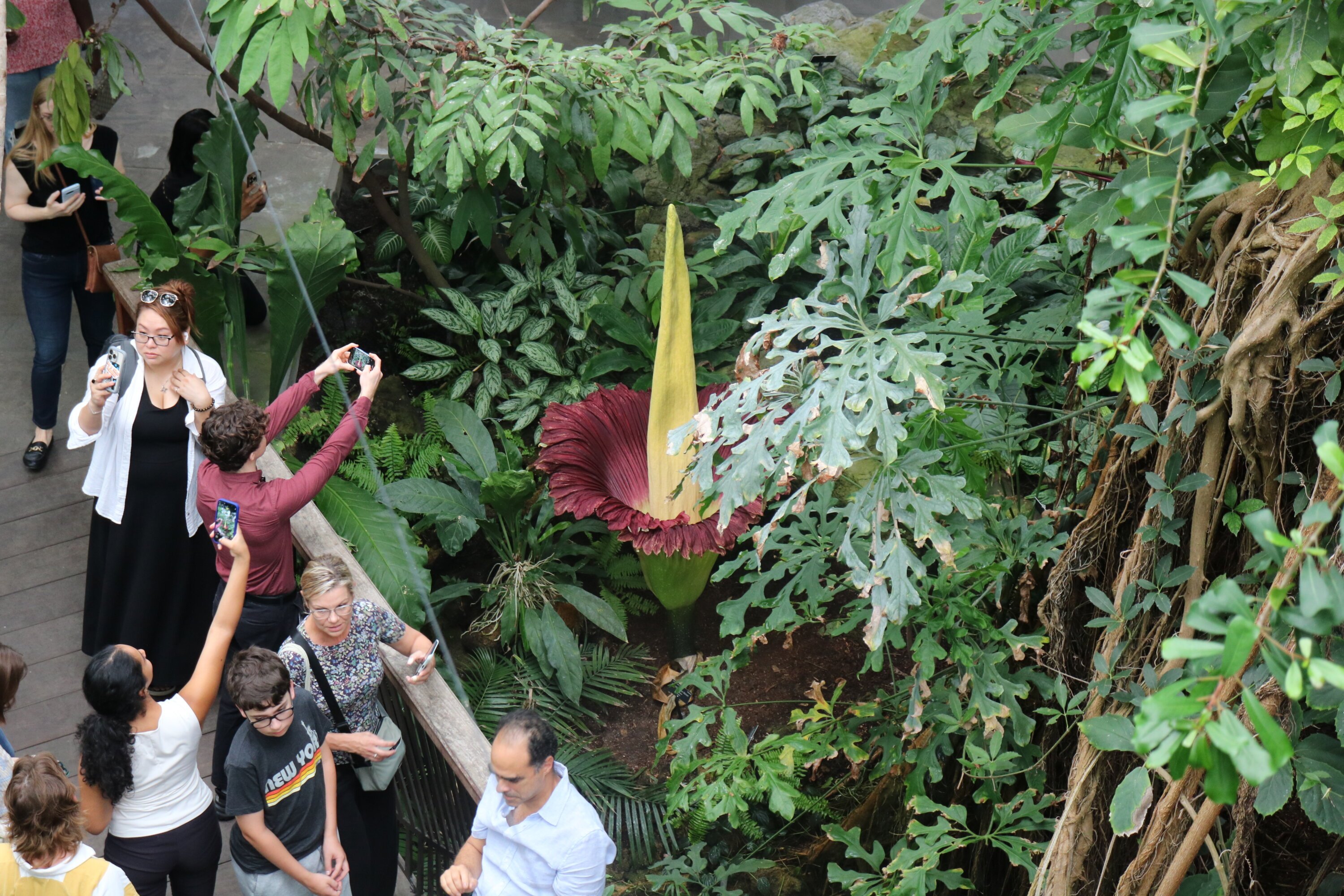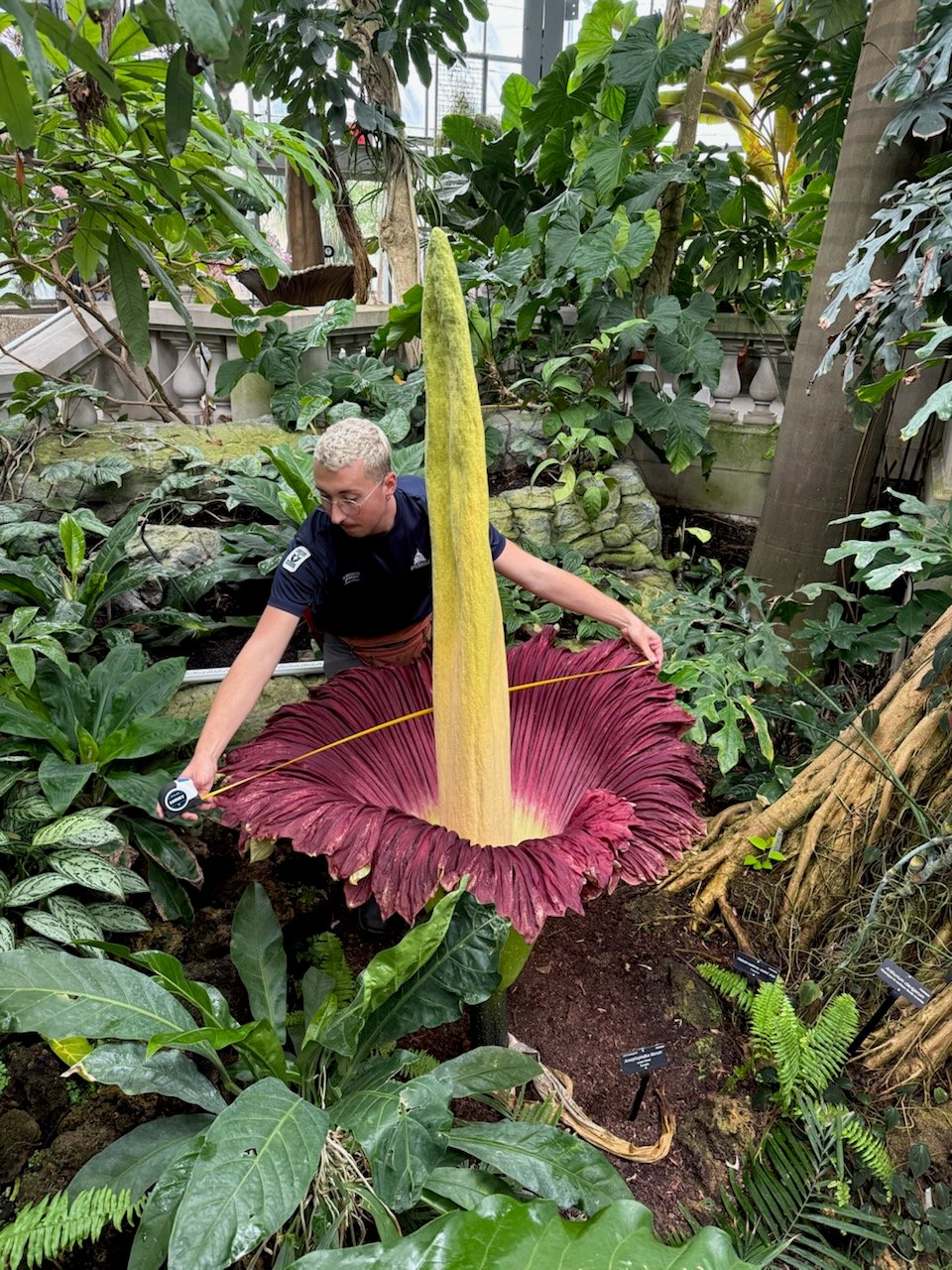The corpse flower in bloom on the US Botanic Backyard. {Photograph} by Katie Doran.
Hundreds of tourists are clamoring to catch a glimpse—or a nausea-inducing whiff—of a corpse flower on the US Botanic Backyard in Washington, DC, throughout its uncommon and fleeting bloom on Tuesday and Wednesday. Within the backyard’s Tropics home, guests swarm the plant like flies to honey. However the corpse flower is not any sweet-smelling bloom: it’s so-named for giving off the putrid odor of rotting flesh, and is taken into account the stinkiest plant on this planet.
Fortunately for these of us much less excited in regards to the corpse flower’s odor, the worst of the stench is over, however the bloom remains to be lovely. A corpse flower, or Amorphophallus titanum, blooms for less than two to 3 days each two to 3 years, with the odor hitting its peak shortly after the plant opens. This corpse flower began blooming on Tuesday afternoon, and smelled foul by yesterday night, in accordance with Devin Dotson, a spokesperson for the Botanic Backyard. However when the backyard opened on Wednesday morning, the odor was largely gone, with solely the occasional whiff of dumpster or rotting roadkill.
The corpse flower’s bloom ought to proceed by way of Wednesday, Dotson says. In the event you haven’t had an opportunity to admire it but, you’ll be able to be part of strains out the door to see the plant till the backyard closes at 6 PM tonight.

At 88 inches tall and 48 inches throughout, the corpse flower is a sight to behold. “It’s a fairly outstanding factor,” one customer tells me. A number of guests converse in hushed, awed voices about what a “as soon as in a lifetime” expertise it’s to see the plant—endearing, however not fairly correct. This corpse flower, which is eight years outdated, will doubtless bloom once more in a pair years or so, and the Botanic Backyard truly has about 35 different corpse flowers, Dotson says. So, if you need to miss this bloom, don’t fret—the backyard could have one or two others blooming later this summer time.


One factor that’s distinctive about this corpse flower, although, is that it’s completely planted within the floor. “For us, this was a science experiment,” Dotson laughs. “Each different bloom we’ve ever had, and just about each different botany backyard wherever, the corpse flowers are all the time in pots as a result of they must be in a particular greenhouse that’s extraordinarily scorching and humid daily of the yr.” Thoughts you, the Botanic Backyard’s Tropics home is scorching and humid (the sweat I’m certain was slowly drenching my face as I did this interview can attest), however the services these crops are usually grown in are much more tropical. These situations are supposed to emulate rainforests in Sumatra, Indonesia, the place corpse flowers are native to. The crops (which aren’t technically flowers, however fairly, inflorescences, or collections of many flowers performing as one) are endangered, with fewer than an estimated 1,000 within the wild.
Corpse flowers stink as a result of they’ve advanced to draw pollinators by emulating useless, rotting animals. “It’s red-colored, it’s smelly, it even heats up,” Dotson says. “All these indicators say, ‘I’m a useless animal carcass. Please come and lay your eggs right here, please deliver pollen from one other plant.’” I escaped the worst of the odor by displaying up about 20 hours after the plant first bloomed, however Dotson provided some gross imagery to assist me think about what I missed: “a useless animal alongside the facet of a street on a scorching summer time day” or “restaurant trash with meals, greens, and meats which have began to decompose within the warmth.”
I can’t say I’m disillusioned to have missed all that. One customer tells me, “[A Botanic Garden staff member] was saying that it solely stinks for a sure time period, and I do know everybody desires to odor it, however perhaps that’s truly a very good factor.” Behind her, a little bit woman runs away holding her nostril—so I suppose a few of us are nonetheless catching the stench.

